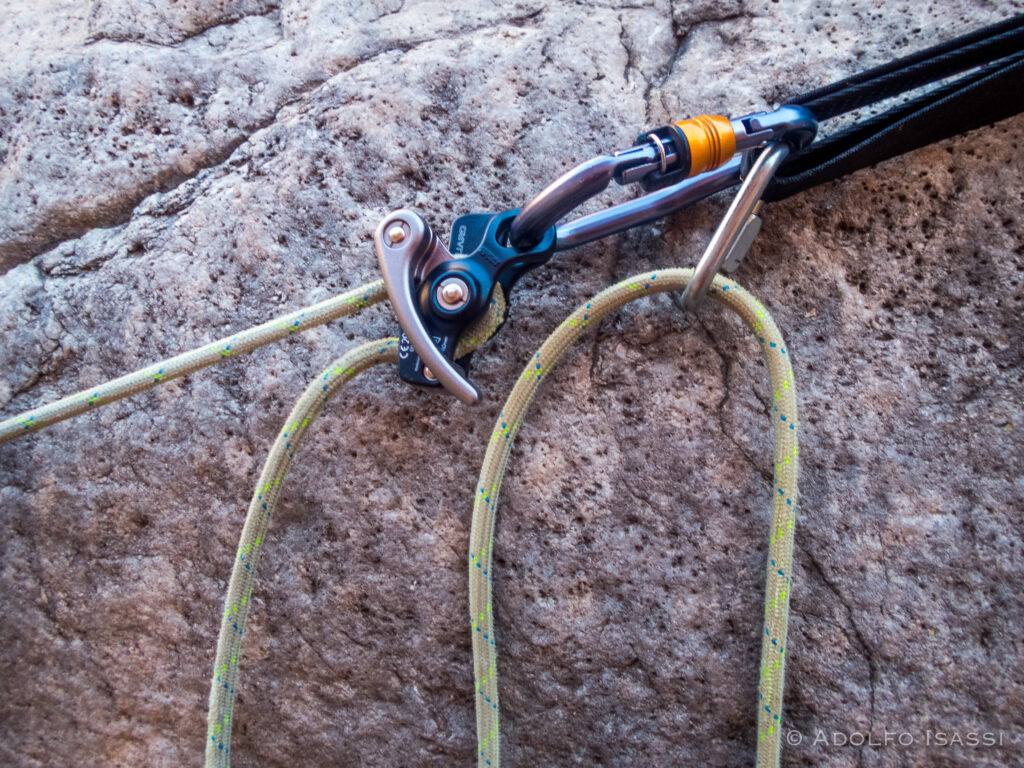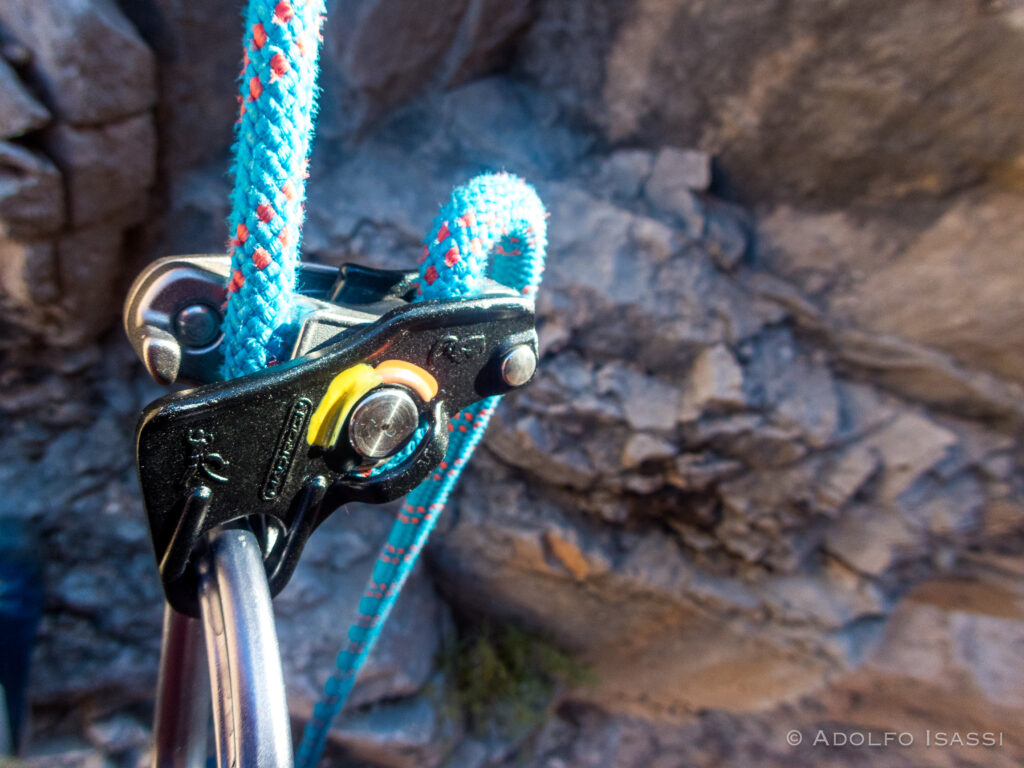
Oher rope related activities like caving, climbing, rope access, have been using self-locking & assisted-braking devices for a while. Devices like the Petzl line up ID, Evac, Rig, Stop, GriGr. Recently, a relatively new device, the Safeguard offered by MadRock has been attracting the attention of canyonners as a compact possibility to carry a self-locking & assisted-braking device into canyons.
For canyoning professional guides, there are some instances where a device like this can become really handy.
- Ascend rope and quickly convert back to rappel without any extra steps
- Rig releasable, set length, and if needed, revert to haul without any extra steps
- Rig releasable and if needed, release with an auto-lock action if we let go of the rope
- Tension a guided rappel with an emergency controlled release

As pro guides, we already have a tool box with several options to accomplish tasks. We have been using implementations like Italian-8, prusik-minding-pulleys, Totem stop-and-go. Satisfactory results with these implementations vary greatly on rope, situation and user dexterity.
In the last years MadRock came out with a couple of Auto-Lock devices that are small and simple enough to attract the attention of canyoning communities. I took the SafeGuard version and use it to test these scenarios:
- As a rappel device with a self-belay mode
- As a releasable device to rig rappels
- As an PCD to ascend and convert to rappel
- As a descender-auto-lock to go down and perform a pick-off

We used Sterling Lux, OnRope CRT, and a beefy 10mm static rope for testing.
Impressions:
As a rappel device with a self-belay mode
I did not like this. It works, but is just not a smooth operation. In order for the rope to flow smoothly, the user needs to keep it aligned with the cam nose (see photos), and the rope just wants to jump out of that position. This is a very natural position while belaying-a-climber but not while rappelling. I hope that in the future, MadRock puts a ‘groove’ in that part of the cam.
As a releasable device to rig rappels
Great application. Fast release and auto-stop if you let go of the rope. Great for setting rope length, just pull up. Also great for hassle free convert to hauls, short or long. The one thing though is that this device needs a really good positioned anchor/master point. Poorly placed anchors with lots of rock contact will trash the device, or make it difficult to operate.
As an PCD to ascend and convert to rappel
Great application. Not as smooth as a Micro Traxion, but the convert to rappel is just a hand to brake, and a lever pull.
As a descender-auto-lock to go down and perform a pick-off
Given the lackluster performance as a rappel device, I was not expecting much for this use-case-scenario. But the prospect of precise positioning for a pickoff, plus auto-lock is very appealing. This worked great. I got too close to the rescuee, and I was able to ascend a bit to get the distance just right. Descending with the weight of 2, was actually a better experience, which made me realize that, just like all other descenders, the device performance is weight sensitive.
Overall:
For a pro guide, I think this device offers limited appeal, given that its functionality overlaps with more lightweight, multi purpose tools that pro guides already carry. However, its compact size and ease of use may offer some appeal for some very specific situations, like bolting or doing route maintenance, setting up practice stations, or maybe as an actual belay device in the occasional lead climb during approach or exit routes.
This device has a CE EN 15151-1 certification in case your operating standards require it, yet the included instructions, or or online reference material, does not show any load ratings.
References:
MadRock Safeguard specs:
Certification:
https://standards.globalspec.com/std/1540615/EN%2015151-1
Other techniques that have been in the toolbox for a long while to achieve these tasks with variable degrees of success:
Totem Stop and Go mode:
Figure 8 PCD/Ascend/Italian mode:

Nice write-up, Adolfo. Thank you.
This type of device comes in handy for rescues that involve a temporary lift to take weight off of one system, then transition to a lower with a rescue rope. Some examples:
(1) Classic “cut and lower” when someone is stuck on rope rigged double.
(2) Ascend past subject, establish a mid-rope anchor, then lower to the ground from that anchor.
(3) Subject is stuck on tail-up toggle-rigged rope.
MadRock Safeguard, Petzl GriGri, etc. shine in these applications because they can serve as a temporary PCD to hold the load after the lift phase and require no additional steps to transition to lowering mode.
A good gear salesman should start pushing the Totem Autoblock function as an alternative, but honestly, it is a high-friction PCD, so the lift will be more difficult, and as a lowering device it requires great care to find the “sweet spot” for safe lowering at a controlled speed. So the salesman side of me can only say that it works ok if you do not have a Safeguard or GriGri.
For a guide I believe it is worthwhile to carry one of these devices in your rescue kit. The Safeguard is the smaller and lighter of the two devices I mentioned. Consider including one in your rescue kit.
I will also add … if you do intend to use the Totem in the rescue applications I mentioned in the previous comment, better to use it in plaquette mode, rather than “stop ‘n go” (aka Italian 8) mode.